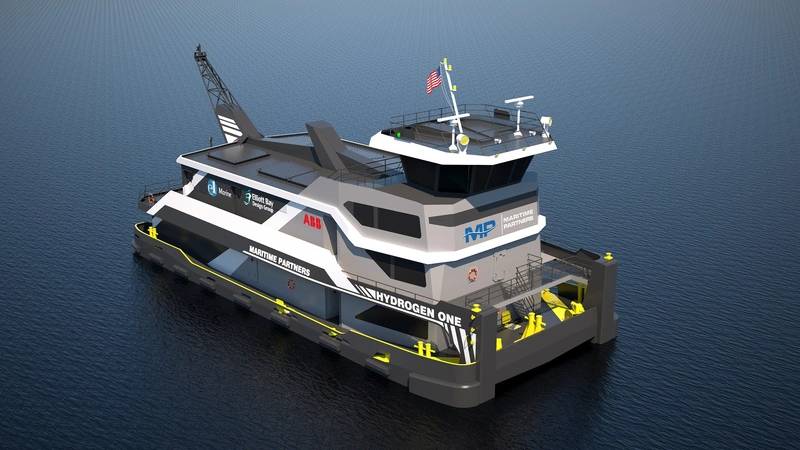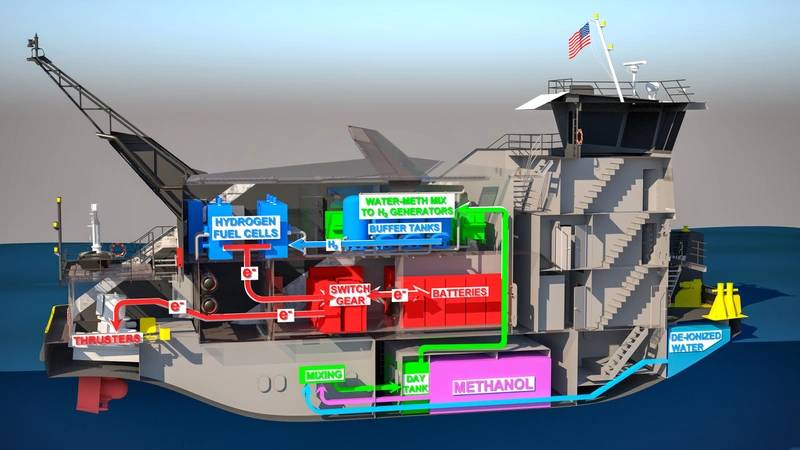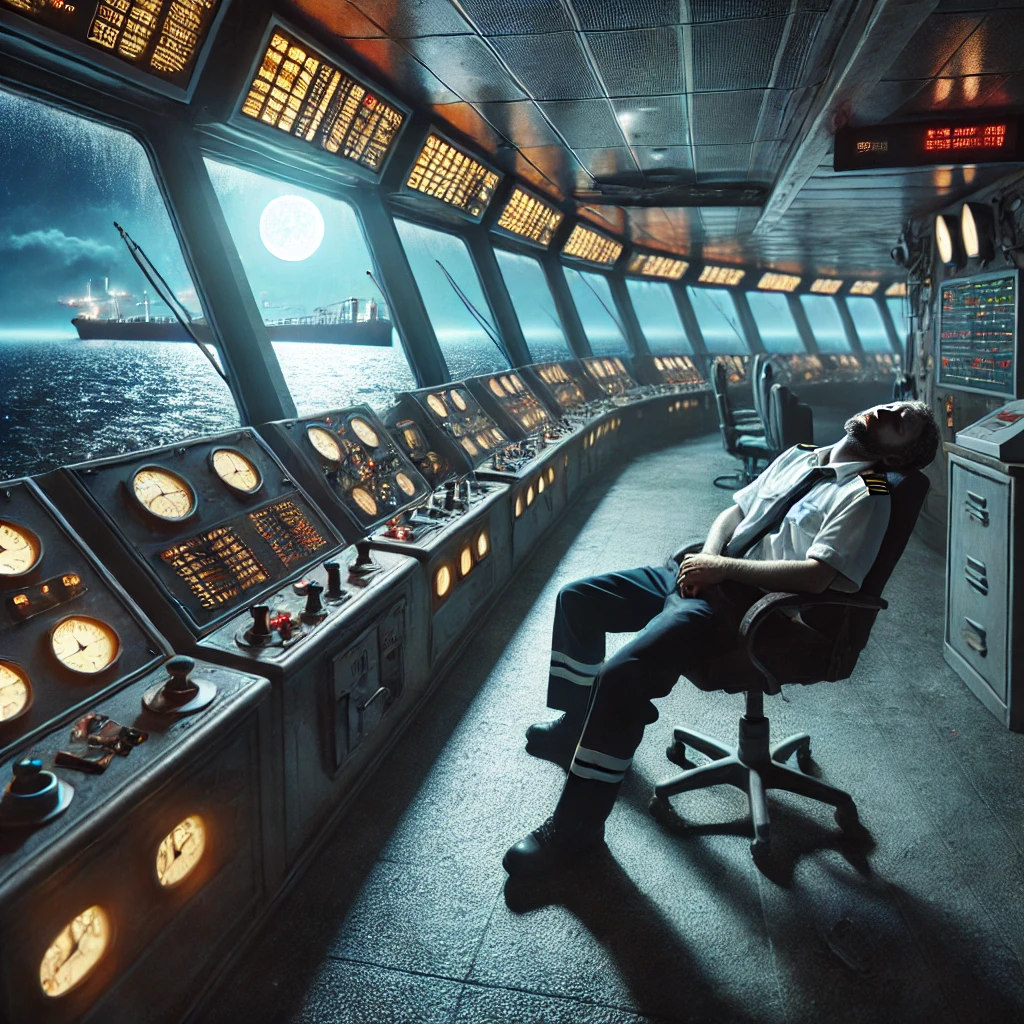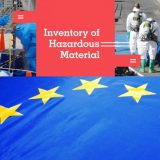Rarely does a vessel come along with the potential to radically change the way an industry operates, but one such vessel is set to hit the water in 2023.
This new vessel, a towboat named Hydrogen One, is being developed by Louisiana-based Maritime Partners, the largest lessor of marine equipment in the U.S. It will be the first of its kind globally to run on emissions-reducing methanol-to-hydrogen generator technology—no diesel propulsion on board—as the maritime industry continues to plot its course toward cleaner vessel operations.
The groundbreaking towboat was designed by Seattle-based Elliott Bay Design Group (EBDG) and will be built at Intracoastal Iron Works in Bourg, La. Other key partners in the project include technology providers e1 Marine, based in Bend, Ore., and multinational ABB. Once completed, the vessel will be operated by Jeffersonville, Ind.-headquartered marine transportation company American Commercial Barge Line (ACBL), likely to move petroleum products in and around Louisiana and Texas.
Seeking a solution
In recent years, marine transportation companies have been exploring a range of greener power and propulsion solutions to help reduce their vessel emissions as stricter environmental regulations take hold and environmental, social and governance (ESG) priorities increasingly drive corporate decision-making and capital allocation.
“The global shipping industry has been driving to decarbonize itself,” Maritime Partners’ CEO, Bick Brooks, said at the 2021 International WorkBoat Show in New Orleans in December. “It’s a huge challenge given the energy requirements for vessels regardless of application. But the winds of change are blowing, and we want to be at the forefront of that change.”
It will take a growing mix of technologies to decarbonize shipping as various vessel applications differ in power and propulsion needs. There’s no one-size-fits-all. Batteries, for example, have been gaining attention for vessels such as ferries and tugboats that operate on fixed, repeated routes where daily charging is possible, but are not currently viewed as a standalone answer for towboats due to these vessels’ size, space and weight limitations, as well as the nature of barging routes on the U.S. inland river system. And limited onboard storage capacity and a lack of necessary dockside bunkering infrastructure essentially strike pressurized or cryogenically stored gases from the list of viable towboat fuels.
“We took a blank sheet of paper and laid out all of the available alternatives: liquefied natural gas (LNG), methanol, ammonia, compressed hydrogen, biofuels; and what we came up with was methanol as the fuel of choice for our application,” Brooks said. “It is widely available throughout the river system and global port infrastructure, it can be distributed in existing fossil fuel distribution infrastructure, and it’s safe.”
Jack Nash, an analyst with Maritime Partners, said at the WorkBoat Show that the company looked at three primary criteria when evaluating the viability of future fuel options: strong emissions benefits, cost competitiveness and strong performance. “If a fuel doesn’t tick all of those boxes, then we struggle to see how it will be adopted,” he said. “We were very impressed with hydrogen’s emissions benefits, but the challenges with transporting and storing hydrogen increased the cost so significantly that we didn’t see compressed hydrogen as a solution moving forward.”
And that’s where e1 Marine came into play with a solution that serves as a link allowing easy-to-handle methanol—a top commodity globally, located in bunker quantities at more than 100 ports—to be converted into power-dense and clean hydrogen on board, in real time.
Mike Complita, principal in charge and VP of strategic expansion at EBDG, said the solution is a good fit for Hydrogen One based on the vessel’s operational profile. While pure hydrogen can be difficult to carry in quantity and get distance, methanol—which is readily available and routinely carried on U.S. inland waterways—is very similar to fueling conventional diesel, Complita said. “You bunker it from a truck or a terminal through a hose. It does not take any special permitting, unlike hydrogen and ammonia and some other alternative fuels,” Complita said. “Methanol, in my opinion, is probably the safest alternative fuel to transfer to the vessel beyond diesel and biodiesel.”
 Hydrogen One will turn heads on the water. Its appearance can be described as somewhere between futuristic and traditional, with modern, sleeker lines paired with many of the signature elements of traditional vessels. But it’s what’s inside that will be the real difference maker. (Image: EBDG)
Hydrogen One will turn heads on the water. Its appearance can be described as somewhere between futuristic and traditional, with modern, sleeker lines paired with many of the signature elements of traditional vessels. But it’s what’s inside that will be the real difference maker. (Image: EBDG)
According to Complita, “The other benefit of methanol is that, similar to diesel, it gives you relatively unlimited range. . . So, we can build a boat that can get similar range to diesel with methanol fuel. That’s not something you can do with electricity [alone]. That’s not something you can do with liquid or gas hydrogen. Other options like ammonia are starting to come online to do that as well, but they are a lot farther out in having the technology ready for that.”
e1 Marine, a joint venture between Maritime Partners, Irish tanker owner Ardmore Shipping and Bend, Ore.-based hydrogen generation specialist ELEMENT 1 Corporation, will supply a methanol-to-hydrogen generator technology for the Hydrogen One. Basically, the system will convert methanol and water into pure hydrogen that will run through fuel cells to create electricity for the vessel’s motors, which drive dual L-drive azimuth thrusters. e1 Marine has tapped RIX Industries to manufacture Hyrdogen One’s M18 reformers and PowerCell Sweden AB to supply the PowerCellution Marine System 200 fuel cells. The vessel will also be equipped with batteries that provide additional power when needed, both while underway and for hotel power.
Robert Schluter, managing director of e1 Marine, noted that the technology is already proven but has typically been used in smaller scale power generation applications—less than 10 kilowatts of fuel cell power. Through the years, the system has been scaled up and is now ready to support the multimegawatt power needs of marine vessels. Hydrogen One will be in the 2,000-horsepower range, but as the technology continues to evolve, towboats could become more powerful using similar methanol-to-hydrogen systems.
Earlier this year, the system received approval in principle (AIP) from classification society Lloyd’s Register following independent verification that the e1 Marine generator can support megawatt scale fuel cell power applications and meets all applicable regulations, codes and standards.
How it works
“In simplified terms, we turn methanol to hydrogen as needed,” Schluter said. “As the fuel cell, which is the engine in this case, needs hydrogen, we just operate the fuel delivery system to provide the hydrogen as it’s needed.”
“The process is robust in design with very few moving parts, requires minimal maintenance and offers outstanding longevity.”
According to Schluter, here’s how it works:
First, methanol (CH₃OH) and water (H₂O) are mixed at a roughly a two-thirds/one-thirds composition to create the feedstock, which is pumped into a heat exchanger to cool the product hydrogen, preheat the feedstock and obtain optimal thermal efficiency for the generator. Then, the pre-heated feedstock flows into the reactor “hot box”, where it is converted into a vapor before being directed into a catalytic reactor to convert the feedstock into a syngas, a mixture of hydrogen, carbon monoxide (CO) and carbon dioxide (CO₂), Schluter said.
Next, hydrogen is separated from the syngas using e1 Marine’s membrane purifier, the heart of the system. The small amount of remaining hydrogen-depleted gas from the purifier is directed back to the reactor and combusted to generate the heat for the steam reforming reaction. Exhaust from the raffinate combustion is sent to the atmosphere, and the only new emissions produced by the hydrogen generator are carbon dioxide and water vapor.
“The hydrogen goes to a small buffer tank, and then the fuel cell pulls off that buffer tank as needed,” Schluter said. “It’s a very small quantity of hydrogen. Less than half a kilogram actually exists at any one time.”
Emissions and economics
Many industries, not just marine, are looking at new technologies that will help clean up and slash emissions. But, risk is inherent to the adoption of any new technology, especially one that has yet to be proven in real-world vessel operations. First and foremost, the system must be proven safe. Beyond this, there are always questions about technical, logistical and economic feasibility. For a vessel owner and operator to sign on to try something new speaks volumes when so much is on the line.
According to ACBL’s CEO, Mike Ellis, the company’s strong relationship with Maritime Partners drew it toward wanting to operate the groundbreaking vessel. “Second, this project aligns with our strategy and ESG goals and initiatives,” he added. “We have to find more sustainable solutions to meet our customer demands. All of these reasons led to our desire to be a part of this project.”
Schluter noted that methanol is very clean in its composition. “It does have a carbon, but it’s only a single carbon. And it naturally biodegrades,” he said. And, with methanol, a vessel operator gets all the benefits of a liquid fuel, like they would with gasoline or diesel, but e1 Marine’s solution is able to safely convert it to clean hydrogen, right at the point of use, Schluter said. No nitrogen oxide (NOx), sulfur oxide (SOx) or particulate matter (PM) pollution. “People are looking to adopt clean power solutions, and the cleanest out there is hydrogen,” he added. “It’s got literally zero emissions. Heat, power and water are its three outputs. And it’s been commercialized for more than 20 years.”
 (Image: EBDG)
(Image: EBDG)
It’s often repeated that the maritime industry—the U.S. towboat industry particularly—has a certain reputation. It’s true that barging is significantly cleaner than road, rail and air transport alternatives, but the industry is not perceived as one that is overly eager to try new things. “We all know this is an industry that is steeped in tradition. It’s very slow to change,” said Eric Livingston, COO at Maritime Partners, speaking at the WorkBoat Show. “However, what we’re hearing from our customers is that they need a decarbonization, low-emission solution on the river; it’s a must. It’s coming from both our customers and our customers’ customers. So, the demand is there.”
One of those customers is ACBL, which is seeking to lead the way in helping the inland waterways transportation industry shrink its carbon footprint. “Our industry must be diligent and innovative to keep our standing as the most efficient mode of cargo transportation for our customer base,” Ellis told Marine News. “We are excited to be a key player in developing a more sustainable reduced carbon footprint supply chain for our customers and all of our stakeholders through our partnership with Maritime Partners on this project.”
And while the environmental benefits of the methanol-to-hydrogen technology are the immediate draw, the economics have to make sense for the solution to be right for Maritime Partners as well as ACBL and its customers.
Asked how the costs to charter and operate Hydrogen One might compare to a traditional towboat, Ellis said, “We, along with Maritime Partners, Elliott Bay Design Group and ABB, recently participated in a very detailed, two-day risk assessment in which many of the operational, compliance and maintenance aspects of the vessel were discussed and considered. At this time, we are still in the discovery phase of determining the operating parameters and costs associated with this vessel.”
Risk analysis workshop
The risk analysis workshop was conducted in July, facilitated by classification society Lloyd’s Register, and attended by staff from the U.S. Coast Guard’s local office in Houma, La. and engineering team in Washinton D.C., as well as the project design team and representatives from ACBL.
“The workshop was highly successful, and the USCG was highly complimentary of the breadth and depth of the team we assembled. At the conclusion of the workshop, all significant identified risks were adequately addressed to the satisfaction of all attendees,” Complita said.
“Lloyd’s has since provided the formal register document which will accompany our updated Design Basis Agreement to be submitted to the USCG. Once the USCG approves the Design Basis Agreement, we will submit the design plans and documents for approval by the Marine Safety Center.
“Coming out of the workshop, the design is substantially complete, and the project remains on schedule with construction starting in the third quarter of this year.”
Ultimately, Maritime Partners believes it is bringing to market a solution that will eventually be able to compete on cost with an EPA Tier 4 combustion engine towboat. “With the adoption of Tier 4, the cost curve is already going up. In order to build a Tier 4 towboat, there is a significant increase in cost versus Tier 3, which gives us the room with this new towboat—even at a higher cost—to come in competitively,” Livingston said.
According to Schluter, e1 Marine is able to show a return on investment (ROI) about five or six years, versus a Tier 4 diesel engine. “That’s very exciting because we’re actually more cost effective in that type of solution five years out,” he said. “This technology can be cost effective. It’s not an R&D project. It’s not the only way we can afford this as a government grant. This is real and ready to go. There is going to be more work in the near term. Hydrogen One is more expensive than what Hydrogen Three will be, right?”
Maritime Partners shares this view and is funding the Hydrogen One project without financial assistance from the government. “It will take a little time, it will take a little scale, but we believe that [cost competitiveness] is a real benefit to this technology,” Brooks added. “It’s not some pie-in-the-sky, highly expensive solution that requires government funding. This is something that can find widespread adoption given the cost competitiveness of it.”
 (Image: EBDG)
(Image: EBDG)
Equipped with ABB’s electrical power distribution and automation technology, Hydrogen One will be able to perform at standard operational speeds for up to 550 miles before it needs to refuel. Better yet, it will meet the International Maritime Organization’s (IMO) 2030 goals, which target 40% reduction in greenhouse gas (GHG) emissions relative to 2008. The vessel will also meet all requirements of the U.S. Coast Guard’s Subchapter M regulations.
Challenges
With any first-of-its-kind vessel comes a unique set of challenges. For Hydrogen One, the sheer size and weight of the on-board power equipment presented a few design and technical tests for EBDG and the team. The fuel cells, reformers and batteries collectively are physically much larger and heavier than a pair of conventional diesel engines of the same power, Complita said. “We had to carefully arrange and balance the boat to accommodate the weight, to put that equipment in an area that’s safe and away from the crew quarters without impacting visibility from the wheelhouse.”
Complita also noted that alternative fuels are typically anywhere from 20 to 80% less energy dense than diesel, meaning a larger fuel capacity is required in order for the vessel to go the distance. “That makes it also technologically challenging to design the boat to have more space to carry fuel, especially in a conventional inland towboat,” he explained. “Hydrogen One is a small boat relative to the power that it generates. And so we need a lot of fuel and a lot of power, and packing that all into that conventional size has been a challenge.”
Dave Lee, VP of sales for global workboat marine systems at ABB, said new technology brings questions about how all the onboard systems will be controlled. “Unlike a traditional boat there are many different subsystems to this boat that have to be controlled independently and then be seamlessly integrated into the overall control at the same time.”
According to Lee, Maritime Partners saw the value in ABB’s “long history of not only electrical propulsion integration but also process automation in many different industries” to help tackle this challenge. ABB has been working closely with EBDG throughout the design process and will assist over the course of the build to ensure Hydrogen One’s systems work together seamlessly.
While a walk down below to the machinery space—not engine room—on board Hydrogen One will reveal a boat that looks very different than a traditional towboat, not much will be changed on the bridge. “It is an important item to any towboat or workboat operator that the wheelhouse is mainly unchanged, and this is no different on Hydrogen One,” Lee said. “For the captain, they will not tell much difference other than the greater response in a boat like this and the fact that they will have a couple more computers in the wheelhouse.”
“The real drawback to any new boat like this is that it is different, and there will be different skills needed to work on and maintain the boat,” Lee said, but added that the industry is willing and ready to advance. “We have gone through this before in the marine industry. You can only imagine what it was like to go from steam engines to diesel engines, or more recently, for operators adopting Z-drives compared to traditional shaftline boats.
“[Hydrogen One] will be different, but the marine industry is ready for something different, and definitely their customers are as well.”
Source: https://www.marinelink.com/news/hydrogen-one-innovative-towboat-set-shake-499381













